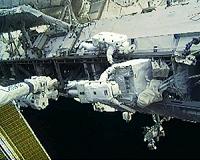 |
Sydney, Australia (SPX) Apr 21, 2011 For the second time, an attempt to take a photograph of a Space Shuttle docked with the International Space Station has been thwarted. Russia has again declined to undock a Soyuz spacecraft for a photographic expedition. It's highly possible that the Shuttle program will end with no clear photograph of an entire orbiter and the entire International Space Station docked together. The technical issues behind Soyuz are better discussed elsewhere, but the decision highlights a shortcoming in spaceflight. There is no easy way to get a camera out to a fair distance from the ISS and take a look back. It's time for some paparazzi in space. We've been down this path before. At various times, small free-flying satellites have been launched to take images of other spacecraft. One was deployed from a Shuttle payload bay in the 1980s, and returned some great pictures of the Shuttle in orbit. There have also been experiments with microsatellites flying openly discussed missions to image other spacecraft, and sometimes photograph the rockets used to launch them. It's also fairly likely that missions like this have also taken place covertly. It really shouldn't be too difficult to do this from the ISS. A small satellite bus with a camera, a navigation system and a set of cold nitrogen thrusters could be tossed out an airlock, then sent on a photographic tour. Russian cosmonauts used to hand-launch small satellites when spacewalking from earlier space stations, and the Japanese are planning to launch some small satellites from their own ISS laboratory module. A small satellite inspector like this would be useful for more than just nice paparazzi photographs. It could be used for technical inspections of areas that would be otherwise difficult to inspect. This could ease the burden on spacewalkers, who must sometimes go outside to check on things. The spacecraft could be attached to an external payload rack, where it could be plucked by a robot arm, deployed on a flight, then retrieved by the arm and returned to storage. Alternatively, it could be stored internally and tossed out a small scientific airlock. This option, however, could make retrieval more difficult. The use of non-toxic propellants and the possible use of buffers around the spacecraft would reduce the potential for damaging the exterior of the space station. A small object like this, with the capability to only make a small change in its velocity, would further reduce the risk of damage in the event of a collision. The technical capability for such a small flying camera has been with us for a long time, and the cost would not be great. In retrospect, such a device should have been sent to the ISS years ago. It's probably too late to launch one before the Shuttle program ends, but the Station itself will be flying for a long time. The loss of the Shuttle will bring a reduction in the ability to inspect the station from spacecraft performing rendezvous. Thus, the need for a paparazzi satellite will be greater than ever. This would be an ideal project for small research teams. Somebody needs to take up the challenge. Dr Morris Jones is an Australian space analyst and writer. Email morrisjonesNOSPAMhotmail.com. Replace NOSPAM with @ to send email.
Share This Article With Planet Earth
Related Links - Station at NASA Station and More at Roscosmos S.P. Korolev RSC Energia Watch NASA TV via Space.TV Space Station News at Space-Travel.Com
 CSA Celebrates A Decade Of Success With Canadarm2
CSA Celebrates A Decade Of Success With Canadarm2Longueuil, Canada (SPX) Apr 20, 2011 Ten years ago, Canadarm2 was launched to the International Space Station (ISS) aboard the Space Shuttle Endeavour. A larger, more robust successor to the Shuttle's Canadarm, Canadarm2 has provided a full decade of flawless service as the Station's sophisticated "construction crane," having assembled the ISS module by module in space. Canadarm2 has unloaded hundreds of tons of equipment and ... read more |
|
| The content herein, unless otherwise known to be public domain, are Copyright 1995-2010 - SpaceDaily. AFP and UPI Wire Stories are copyright Agence France-Presse and United Press International. ESA Portal Reports are copyright European Space Agency. All NASA sourced material is public domain. Additional copyrights may apply in whole or part to other bona fide parties. Advertising does not imply endorsement,agreement or approval of any opinions, statements or information provided by SpaceDaily on any Web page published or hosted by SpaceDaily. Privacy Statement |